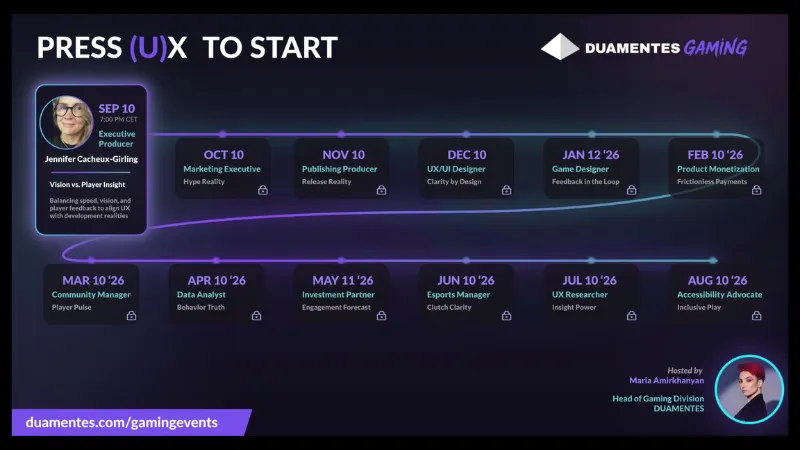
For both AAA studios and gaming startups, success now depends on mastering one balance: insight, speed, and scope. Player experience drives everything, yet small teams face brutal constraints: short funding runways, shifting markets, and limited UX resources.
That’s what Jennifer Caheux-Girling, executive producer, and Maria Amirkhanyan, Head of Gaming at Duamentes, explored in a recent discussion on building player-first pipelines that scale, even when time and budget don’t.
“It’s harder than ever to read the market,” says Jennifer Caheux-Girling. “Risks are high, investment is dropping, and mistakes are expensive.”
1. The Core Tension
The gaming economy has become a winner-takes-all arena. Titans like Fortnite, Minecraft, Roblox, and Genshin Impact capture most playtime and funding. For startups, that means zero room for blind spots.
“Player-first” can’t just be branding, it’s operational discipline. Teams must learn to validate fast, interpret data, and pivot with confidence before funds or attention run out.
2. Player-First ≠ Player-Only
Being player-first isn’t about outsourcing design to feedback threads. “Players will tell you there’s a problem,” says Caheux-Girling, “but they might not see the full picture of the game, the audience, or the business.”
Startups especially risk chasing the loudest Reddit or Discord comments — not the real majority. The fix: combine qualitative signals (player feedback, interviews) with quantitative evidence (telemetry, store metrics).
Player-first means thinking critically, not reactively — using insight as a compass, not a roadmap.
3. Speed vs. Research
Many early-stage teams skip research to “move fast.” But done right, research is acceleration, not drag.
When War Robots: Frontiers tested its complex robot builder feature early, it “prevented expensive late pivots,” recalls Jennifer. Even five quick playtests can reveal onboarding issues that would cost months later.
Lean validation, short, focused tests instead of long reports, gives startups a crucial advantage: speed with direction.
4. Prioritize What Actually Moves the Needle
When everything feels urgent, founders and producers must filter noise.
Jennifer’s rule: start with high-impact systems that define experience, onboarding, core loop, monetization flow.
Use the Impact × Urgency grid:
- High impact + high urgency: test immediately.
- High impact + low urgency: plan validation in later milestones.
- Low impact + high urgency: fix fast with light checks.
- Low impact + low urgency: postpone or cut.
This simple prioritization framework helps early teams act on insight, not drown in it.
5. Indie Reality Check
Smaller teams can’t afford full UX pipelines, but they can still validate what matters.
When Duamentes joined the indie title Casting Whispers late in production, there was no time for long studies. Instead, the focus was sharp: store page clarity, onboarding flow, first-session friction.
Even minor tweaks turned confusion into clarity and boosted conversions.
Lesson for startups: you don’t need scale to run smart validation. You need focus.
6. Culture Eats Process
Research shouldn’t be a phase; it’s a habit. The best producers treat validation like CI/CD for design: continuous, lightweight, and data-informed.
“When teams understand that validation prevents costly pivots, protects creative vision, and builds confidence in every release,” says Caheux-Girling, “research stops feeling like a slowdown and starts feeling like a competitive edge.”
That’s how lean gaming teams outlearn, not outspend, their rivals.
Player-First, Founder-Ready
For gaming startups, “player-first” isn’t endless testing, it’s disciplined iteration.
Quick UX research, usability checks, and store-page analytics can reveal what matters before scaling.
“Players decide if a game succeeds,” says Caheux-Girling, “but teams must balance player experience with production realities. Building habits around player insight not rigid processes, is what helps a game stand out.”
Bonus: From Insight to Impact
Duamentes Gaming Research helps teams from emerging studios to funded scale-ups embed UX research and player testing into development from day one.
We validate concepts, test store visibility, and run longitudinal playtests to guide live-ops and retention. Our approach turns player data into production decisions that help teams ship faster, smarter, and with confidence.
Research should accelerate decisions, not slow them down.
Download our checklist to design milestones that are player-focused, insight-driven, and production-ready.





